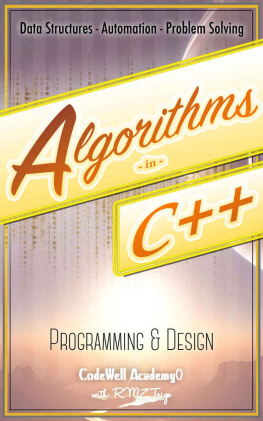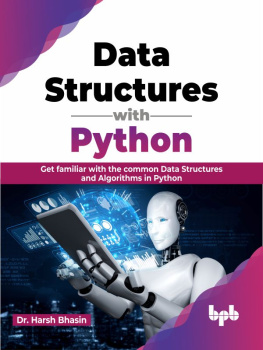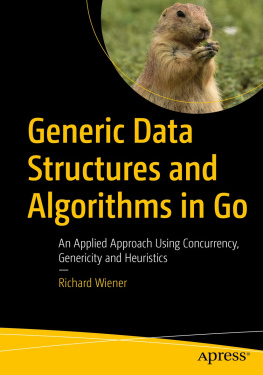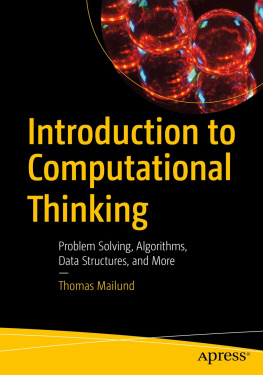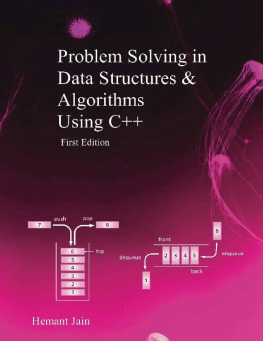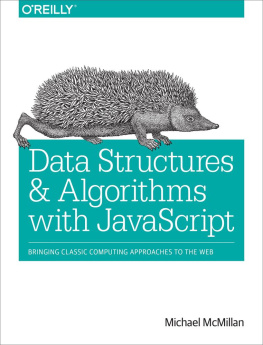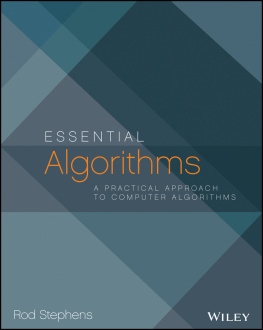Academy Code Well - Algorithms: C++: Data Structures, Automation & Problem Solving, w/ Programming & Design
Here you can read online Academy Code Well - Algorithms: C++: Data Structures, Automation & Problem Solving, w/ Programming & Design full text of the book (entire story) in english for free. Download pdf and epub, get meaning, cover and reviews about this ebook. year: 2015, genre: Computer. Description of the work, (preface) as well as reviews are available. Best literature library LitArk.com created for fans of good reading and offers a wide selection of genres:
Romance novel
Science fiction
Adventure
Detective
Science
History
Home and family
Prose
Art
Politics
Computer
Non-fiction
Religion
Business
Children
Humor
Choose a favorite category and find really read worthwhile books. Enjoy immersion in the world of imagination, feel the emotions of the characters or learn something new for yourself, make an fascinating discovery.
- Book:Algorithms: C++: Data Structures, Automation & Problem Solving, w/ Programming & Design
- Author:
- Genre:
- Year:2015
- Rating:5 / 5
- Favourites:Add to favourites
- Your mark:
- 100
- 1
- 2
- 3
- 4
- 5
Algorithms: C++: Data Structures, Automation & Problem Solving, w/ Programming & Design: summary, description and annotation
We offer to read an annotation, description, summary or preface (depends on what the author of the book "Algorithms: C++: Data Structures, Automation & Problem Solving, w/ Programming & Design" wrote himself). If you haven't found the necessary information about the book — write in the comments, we will try to find it.
Academy Code Well: author's other books
Who wrote Algorithms: C++: Data Structures, Automation & Problem Solving, w/ Programming & Design? Find out the surname, the name of the author of the book and a list of all author's works by series.
Algorithms: C++: Data Structures, Automation & Problem Solving, w/ Programming & Design — read online for free the complete book (whole text) full work
Below is the text of the book, divided by pages. System saving the place of the last page read, allows you to conveniently read the book "Algorithms: C++: Data Structures, Automation & Problem Solving, w/ Programming & Design" online for free, without having to search again every time where you left off. Put a bookmark, and you can go to the page where you finished reading at any time.
Font size:
Interval:
Bookmark:
R.M.Z. Trigo
Under no circumstances will any legal responsibility or blame be held against the publisher for any reparation, damages, or monetary loss due to the information herein, either directly or indirectly. Respective authors own all copyrights not held by the publisher. Legal Notice: This ebook is copyright protected. This is only for personal use. You cannot amend, distribute, sell, use, quote or paraphrase any part or the content within this ebook without the consent of the author or copyright owner. Legal action will be pursued if this is breached.
Disclaimer Notice: Please note the information contained within this document is for educational and entertainment purposes only. Every attempt has been made to provide accurate, up to date and reliable complete information. No warranties of any kind are expressed or implied. Readers acknowledge that the author is not engaging in the rendering of legal, financial, medical or professional advice. By reading this document, the reader agrees that under no circumstances are we responsible for any losses, direct or indirect, which are incurred as a result of the use of information contained within this document, including, but not limited to, errors, omissions, or inaccuracies. Table of Contents Introduction ========================= ====== Welcome to the Path of Mastery We thank you for purchasing & downloading our work, Algorithms.
We understand you want to expand your Programming skills to a deeper, more advanced level. You want your apps to be more sophisticated; you want them to auto-generate results or processing tons of information for you - all in the fastest, most efficient way possible. But before all that can happen, you need a great start. Hence, youve come to the right place Algorithms Algorithms can be as simple as a few lines of good code, or as complex as an Artificial Intelligence bot. How does a Search Engine give you thousands of web pages based on the phrases you enter? How does a search engine finish your search keywords before you even finish typing? How are puzzles randomly created - or automatically solved? How is a list of names instantly sorted in alphabetical order? To understand computing is to understand algorithms. To craft a good algorithm is to give a computer system a really good set of procedures.
And these procedures create answers, manage data, or generally do some work for you - all in the most efficient instructions possible. And, more importantly, to craft a good algorithm is to understand how all the data will be arranged and laid out. Then, how quickly and easily the algorithm or computer can pick a data item and process it. The Master Structure At this point, you pick up where youve left off in your coding journey. You know the basic data types, functions, and other programming terms. You may have started to code using a different programming language; or you may have chosen this books main language.
Either way, youre here to enhance your skills. We start with computing a list of data items. We take a good look at the data and how it behaves, then identify the proper data structure that comes along with it. Then we add the functions and methods that are essential to the data structure. And as the book progresses over time, we start to take a look at more complex data arrangements. Pseudocode Reference This book comes in its own main language and an easily identifiable pseudocode.
The pseudocode is included to teach you one major thing: to recognize the common procedures between the two codes. You can find them at the Reference Section, as well as throughout the book. Afterwards, once you master the material in the books main language, you can use the pseudocode to help you transition into your next language. Overall, good luck and code well. This is the start of something good. ========================= ====== C++ Introduction
C++ programs can use algorithms for managing and manipulating not only lists and collections, but system aspects (like memory) as well. This is because of the procedural speed and memory management in C++. C++ Workshops: Just like our other works, these workshops are yours to complete in whichever way you like. Theyre designed to put recent concepts into real-life practice. Yet they also give you flexibility and critical thinking along the way. And of course, flexibility and deep critical thinking are key programmer traits! Find them throughout the book! ========================= ====== WAIT!! Its best to know the coding fundamentals before you move forward.
If you feel like you need to, you can start with our Programming: Masters Edition Series Click here to view.
We also have Sample Chapters throughout the book to help you out. Part 1: Identifying the Data Types Chapter 1a: Abstract Data Types: The Stack The Stack A stack is literally what it is - a stack of objects. And as an abstract Data Type, the stack would hold a list of data objects for later processing. The data objects in a stack would be inserted and retrieved in a Last-In-First-Out process. A Stack will usually have two main functions defined along with it: push (aka insert) and pop (aka remove/retrieve). How the Stack Works Think of a stack as a pile of plates stacked on top of one another.
And each plate had a letter in it. The top plate would be the easiest to retrieve. So retrieving a data object from a Stack would be the last object that was entered. For example, lets have a stack of dishes as an array: // stackOfPlates are a collection of strings // Each string resembles a Plate string stackOfPlates[5] = {A, B, C, D} If you wanted to insert a new plate in this stack, it would be placed at the end of the list. Now, for example, lets take a look at this stack: string stackOfPlates[5] = {A, B, C, D} Then, lets enter a plate called E. To enter items into a stack, you need a function to insert it into the stack.
This function is usually called push(). stackOfPlates.push(E) Afterwards, heres what the stack would look like: string stackOfPlates[5] = {A, B, C, D, E} If we wanted to retrieve a plate from this stack, the LAST item in the collection would be removed from the stack. Then that item would be given. You need a function to remove and retrieve an item from the stack. This function is called pop(). // This would print E print(stackOfPlates.pop()) // This would print D print(stackOfPlates.pop()) // This would print C print(stackOfPlates.pop()) Then, heres what the stack would look like afterwards: string stackOfPlates[5] = {A, B} When to Use the Stack Carefully look at how a list of data objects should be processed.
Once you notice it uses a Last-In-First-Out process for any data objects that enter or leave, use a stack. Also, complex algorithms and functions use stacks. If a computer processes a procedure as a stack, it will stack all the functions that are called. Then it will proceed to complete each function called, starting with the most recent (youll learn more about all this in-depth later). For future reference, picture yourself in a tech interview. If you ever are asked how a certain functions procedure works, youll be very fortunate to know how a stack works and how that function will proceed from start to finish.
Font size:
Interval:
Bookmark:
Similar books «Algorithms: C++: Data Structures, Automation & Problem Solving, w/ Programming & Design»
Look at similar books to Algorithms: C++: Data Structures, Automation & Problem Solving, w/ Programming & Design. We have selected literature similar in name and meaning in the hope of providing readers with more options to find new, interesting, not yet read works.
Discussion, reviews of the book Algorithms: C++: Data Structures, Automation & Problem Solving, w/ Programming & Design and just readers' own opinions. Leave your comments, write what you think about the work, its meaning or the main characters. Specify what exactly you liked and what you didn't like, and why you think so.

